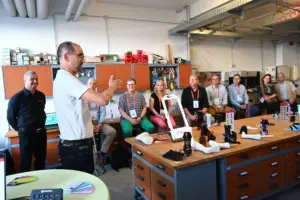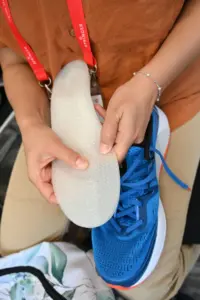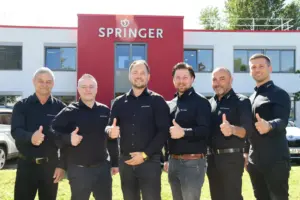15 September 2023
Convention "Digital Manufactory"
Outlook into the digital future
"Digital craftsmanship - manpower of the future" was the motto of the Springer Aktiv AG convention on 15 September in Berlin. In five workshops, technologies and strategies were presented with which orthopaedic (shoe) technology can make work easier and position itself for the future.
"Due to the increasing shortage of skilled labour, digital manufacturing will also gain enormous relevance in the orthopaedic trade"
Frank Hepper, CEO of Springer Aktiv AG, explained this in the run-up to the event. However, simply being able to scan feet and body parts better and carry out analyses is not the solution. A good and effective tool still requires an expert. But the question is also where they are deployed. "Experts are needed, but please in the right place," says Hepper. "Not in the implementation of simple standards, moving pads back and forth or documentation, but where real expertise and specialisation is needed." Hepper is convinced that digital tools can make work easier. It is therefore important to map previous analogue processes digitally and to tackle the associated transformation processes.
At the Springer Convention in Berlin, 80 participants from all over Germany learnt how this can be achieved in practice. Instead of a series of lectures, Springer decided to divide the five planned topics into workshops. This provided the opportunity to discuss the questions and topics in smaller groups. A repetition and rotation meant that all participants were able to take part in all workshops.
Under the title "Digital craftsmanship" - additive manufacturing in the orthosis workshop, master orthopaedic technician Axel Ruppert presented his thoughts and ideas on how additive processes can relieve employees. The best employees are needed on the patient and in the workshop. In view of the shortage of skilled labour, however, there is a risk that these employees in particular will be overloaded with too many tasks. Using the example of orthosis production, he presented how additive manufacturing (3D printing) can relieve employees in production and enable them to use their expertise on patients. The new technology could also create attractive, future-orientated jobs. Relieving the burden on employees through greater efficiency in the supply and production process was a recurring theme throughout the workshops. Boris Hermsen, Key Account Manager at Springer, together with Henning Schnittger, Managing Director of technology partner go-tec, demonstrated the potential for optimisation in the insole process. From their point of view, this applies not only to advice on insole supply, but also to operational processes. Particularly when a company operates several sites, it is important to ensure that all departments have access to all order-related data at all times, from order acceptance to production and product delivery. This means that all processes must also be mapped digitally. Employees could also be supported by digital tools when advising on insole supply in order to sell "added value" for the insoles.

















Torsten Pieper and Andreas Bauer from the Research and Development department at Springer, together with Andreas Schäuble from Strategic Sales at Springer, presented solutions, tricks and tips for digital insole production. Among other things, they focussed on how digital measurements can be efficiently combined with insole production. Questions were answered about how designs can be created regardless of location, as well as how reorders can be organised to save time. It was also shown how progress checks, comparisons and care progress can be carried out in a traceable manner.
In his workshop, Johannes Schiffels, OSM at motioncheck Orthopädie Schuhtechnik Woltring, demonstrated strategies from his own day-to-day care for the efficient, cost-effective and yet individualised treatment of patients with various foot problems.
According to Schiffels, it is also possible to significantly reduce the level of stress for skilled workers during the manufacturing process thanks to the division of labour. The patented single-insole fitting concept therefore follows the approach of being able to fit all relevant foot indications with just a few insole models. This saves time and money.
Steven Simon, a doctoral student in sports science at the University of Kaiserslautern, focused on standardisation in the care process for sensorimotor foot orthoses and their documentation. From Simon's point of view, standardisation means that patients and customers can be provided with the same quality of advice and care, regardless of which employee is responsible. In addition, knowledge can be kept in-house if an employee leaves. In his workshop, Simon presented digital tools that help to implement internal standards and make it easy to log all analysis and production information and make it available at any time.